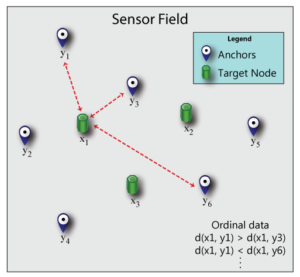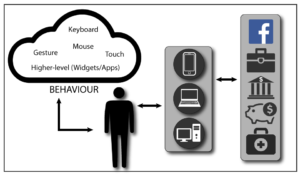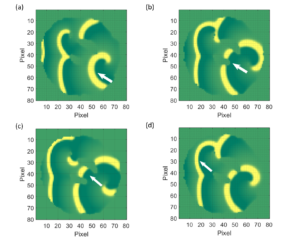NEW!
Demo on password hardening based on our research in behavioral biometrics
 RAPID Project on COVID-19 Hotspot Detection
RAPID Project on COVID-19 Hotspot DetectionIn order to open up the economy in light of the reality of COVID-19, a suite of solutions is needed to minimize the spread of COVID-19 which includes providing tools for businesses to minimize the risk for their employees and customers. It is important to detect transmission hotspots where the contact between infected and uninfected persons is higher than average. This project will provide information to assess precisely the size, density, and locations of COVID-19 hotspots and enable issuing well-informed advisories based on data-driven continuous risk assessment. Every step will be taken to ensure privacy and network security and specific algorithms will be developed for secure access and information transfer. The project will access databases at CDC, Johns Hopkins, and the WHO, and create a comprehensive website to disseminate real-time localized COVID-19 hotspot data while maintaining privacy. The project will create new algorithms and embed them in iOS and Android apps that will continuously interact with databases. The software for mobile devices as well as central hubs will be made publicly available through APIs for use by the broader community.
More details at:
https://sites.google.com/clarkson.edu/cu-cosine-lab/home/rapid-project-on-covid-19-hotspot-detection

UNLOC: Optimal unfolding localization from noisy distance data
We formulate target localization as an inverse problem: given the locations of a set of anchors and noisy distance measures to a target, the localization problem is to estimate the (unknown) location of the target. We propose to solve the localization problem using an unfolding-based optimization.
We show that the corresponding stress optimization, despite being a nonlinear problem (a quadratic objective function with quadratic constraints), yields a global optimum that can be approximated using an efficient iterative algorithm.
We term our computational approach as UNLOC (unfolding-based localization) and benchmark its effectiveness on both synthetic data and lab-generated experimental data. The proposed localization technique generally produces accurate target location, and the quality of localization can be further improved by an appropriate choice of weights in the objective function of optimization.
Paper in Sampling Theory in Signal and Image Processing (pdf)
 Ordinal UNLOC
Ordinal UNLOC
A major challenge in indoor localization arises from the lack of reliable distance measures due to the presence of walls, floors, furniture, and other dynamically changing conditions such as the movement of people and goods, varying temperature, and air flows.
In this work, instead of direct use of unreliably measured distances, we consider ordinal data that are obtained from pairwise distance comparisons. Such ordinal data are generally more reliable than direct distance measures. We develop a computational framework, Ordinal UNLOC, to estimate the location of targets based on ordinal data.

Behavioral Biometrics
We are investigating novel behavioral biometric modalities that involve using a user’s fine-grained application usage behavior to identify him/her and protect online eCommerce and other critical infrastructures, even in the presence of identity theft and insider threats. We will use tools from machine learning and pattern recognition, including transfer learning, longitudinal methods, and deep learning to create user profiles, and perform classification tests for detection and identification.
 Modified Localization Algorithms for Biomedical and Environmental Applications
Modified Localization Algorithms for Biomedical and Environmental Applications
Irregular heartbeats at the root of atrial fibrillation (AFib) have been observed as reentrant electric rhythms induced by spiral waves. Eliminating the center of the rotor or wave core using treatments such as ablation therapy has been shown to be effective in treating AFib, but its success relies crucially on accurately locating the core. We modify localization algorithms to estimate the core. Our algorithms can solve the localization problem without requiring knowledge of the time of origin of the reentrant rhythm, or the speed of propagation of electrical signals along the surface of the heart. We validate the effectiveness of our algorithms in FitzHugh–Nagumo type heart simulation models. Our approaches can also be extended to applications such as in forest fires to estimate sources and rates of growth.
Paper at the Asilomar Conference on Signals, Systems, and Computers (pdf)
 Location Estimation and Detection in the Presence of Fading
Location Estimation and Detection in the Presence of Fading
Localization using narrowband communication signals are considered in the presence of fading channels with TOA measurements.
In a location estimation formulation, the Cramer-Rao lower bound for localization error in fading is derived. The loss in performance due to Rayleigh fading with known phase is computed. Unknown phase causes an additional loss. The maximum likelihood estimators are also derived.
In an alternative distributed detection formulation, each anchor receives a noisy signal from a node with a known location if the node is active. Each anchor makes a decision as to whether the node is active or not and transmits a bit to a fusion center once a decision is made. The fusion center combines all the decisions and uses a design parameter to make the final decision. We derive optimal thresholds and quantify performance.
Paper in Physical Communications (PHYCOM)
Distributed Computing
The analysis of a distributed consensus algorithm for estimating the maximum of the node initial state values in a network is considered in the presence of communication noise. In the absence of communication noise, maximum is estimated by updating the node state value with the largest received measurements in every iteration at each node. However, due to additive channel noise, the estimate of the maximum at each node has a positive drift at each iteration and this effect results in nodes diverging from the true max value. Max-plus algebra is used as a tool to study this ergodic process, wherein, at each iteration, the state values are multiplied by a random matrix characterized by the noise distribution. The growth rate of the state values due to noise is studied by analyzing the Lyapunov exponent of the product of noise matrices in a max-plus semiring.

Reflections app
The “Reflections” app is audio-based and utilizes echolocation to perform ranging. A signal is generated and transmitted through the speaker of the Android device. The signal travels through the environment, strikes objects, and reflects back towards the device. The sent and received signals are used to calculate the time needed for the signal to be sent and received, and a distance estimate is calculated.
The app can be downloaded from https://play.google.com/store/apps/details?id=edu.clarkson.reflectionapp
Paper submitted to FIE 2017 describing the use of the app for Undergraduate Education
 Acoustic Room Characterization
Acoustic Room Characterization
The purpose of this study is to classify different types of rooms based on their acoustic properties. We used the CoSiNe Lab’s Reflection App for data collection. Several recordings were taken in different rooms with the recording device pointing in all directions. Using several discriminating features, we use different machine learning algorithms to create models that differentiate between different types of rooms and the different positions within the room. Preliminary results show that classification accuracy of 88.64% is possible.